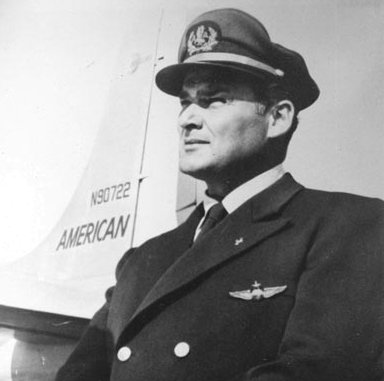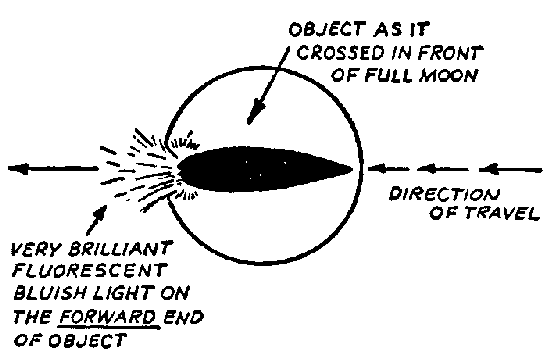Notes on telephone interview with Capt. Willis T. Sperry
on Sunday, February 11, 1968, 10:00 p.m.
He confirmed that he had to put the DC-6 into a 45-degree bank to the right, under the impression that evasive maneuvers were necessary. When the object had come to rest, they leveled off and even turned left again. It hovered there a short time, and then circled around behind them to the copilot's side (right). It appeared to be motionless on the right side for ten to fifteen seconds. Their estimates of the distance were admittedly very uncertain, but he thought it might have been only 400 or 500 yards away at that time.
He said it was a clear night and the moon was almost full. The silhouette of the object covered almost the full diameter of the moon, he thought. He confirmed that it passed right across the moon, so they got a full silhouette of it. No flames were visible in contrast to Ruppelt's account), just a glow visible in the forward part. Rather bright. He recalled that the glow was visible even when the object was passing in front of the moon.
He said the object looked very much like a fireball [he said "bolide") as it came down. But then it was stationary. "We were rather dumbfounded." Then it moved around to their rear. He said it was hard to estimate the speed as it moved around to their rear, but it was very much like somebody moving a sparkler around rapidly in a dark room. He stated the object was definitely stationary on two occasions.
When it got around on their right, it was there ten or fifteen seconds. They swung the plane once again around to a heading of about 330 degrees (NW). They had turned in order to try to see the object again as it remained stationary. Then it took off, heading almost due east and gradually climbing. They swung around left and headed into the east and picked it up again, by which time it was a considerable distance away, climbing out. He recalls that it was around 30 degrees above the horizon when it disappeared. He believes that they watched it move off to the east for at least a minute, as it climbed and got smaller and smaller. He said that one stewardess called it to the attention of the passengers. After they made their abrupt right turn, one of the stewardesses came up front to ask them what was going on and then went back and explained to the other stewardess. By that time, some of the passengers on the left side were looking at the object, as it hovered on the left. A moment later, when it was around on their right, passengers on that side saw it. He thought that there were more than twelve passengers aboard. I failed to ask him who interviewed the twelve passengers or how that number was established.
I asked him about press interviews, however. He said, yes, there were queries even from as far away as Hong Kong, China. His destination on that flight was Tulsa, and they arrived there around two in the morning, as he recalls. The story broke loose the next morning, and they were interviewed there in Tulsa. Both Tulsa and Ft. Worth papers carried it, he knew for sure.
Sperry was on the left, William Gates (co-pilot) was on the right. I asked him about Gates and learned that he was killed in 1951 or 1952 in an American Airlines Convair accident, going into St. Louis.
I asked him about the flight engineer, and he said that he is no longer with American Airlines. Sperry thought that he was in Dallas and will check with the company to see if he can locate his address and then send it to me.
He said, in reply to my query, that he was interviewed by the Air Force. It was a few days later. He said that Al Chop called him long distance in Tulsa. His base was Tulsa at that time. That was the only Air Force interview that he recalls. (Check to see whether Al Chop was in UFO investigation work at that time.)
Queried him in my letter of 2/12/68, as to whether he had been interviewed by Colorado.

